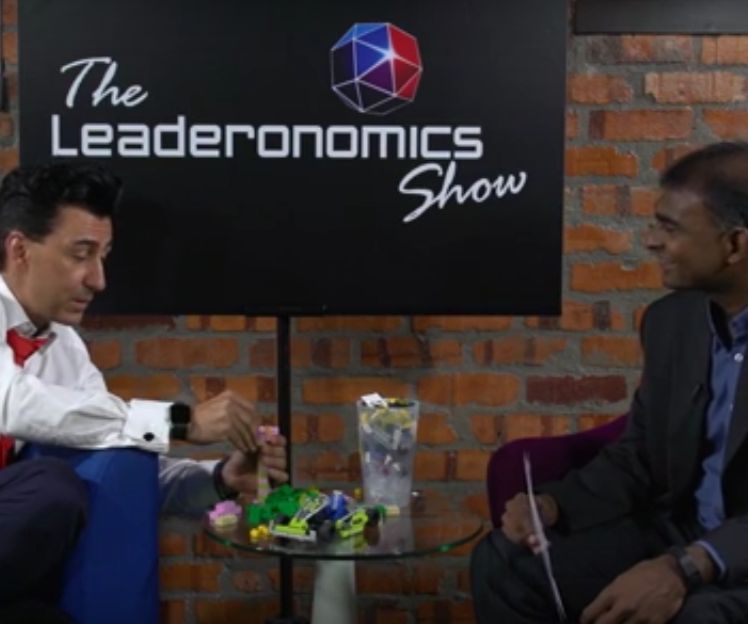Leading In A Disruptive World: Key Takeaways from the Global Leadership Summit 2023 (Part 1)

In recent times, businesses are facing continual disruptions that shake up how they operate. To tackle these challenges head -on, GLS Business and Leaderonomics with Kuala Lumpur Kepong Berhad as the strategic partner brought together the recent Global Leadership Summit.
The morning of the Summit was vibrant with attendees mingling over coffee and breakfast, creating a warm atmosphere. It was great to see people connecting, sharing ideas, and taking selfies. These casual interactions added a touch of camaraderie, setting the stage for the day's insightful discussions and presentations.

Roshan Thiran breaking down insights for the attendees
Unlocking the Power of Trusted Relationships
Richard Beaumont’s compelling talk delves into a transformative journey through the Congo, revealing profound lessons about trust, empathy, and relationship dynamics. His adventure to a risky water project funded by the Entrust Foundation shows us the true value of real connections and having a clear purpose.
Beumont shared an important view on the complex relationships in our lives, asking three key questions that help us deal with these intricate connections.
- How do you build trust?,
- How do we get our thinking right?, and
- How can we thrive in our relationships?
Whether positioned as a leader, alongside one, or aspiring to become one, he emphasised the pivotal nature of relationships in all spheres, underscoring that without solid connections, everything falters. He stressed the significance of building trust, aligning our thinking, and fostering thriving relationships as foundational pillars. In his words, 'If we don't get our relationships right, we get nothing right,' succinctly illustrating the critical role of trust in every facet of our existence, be it in business, government, or personal interactions."
How do we build trust?
In this engaging discourse, Beumont highlights the pivotal role of trust in every facet of life. He introduces a formula - T + E + C = T, that explains how trust works.
- Transparency means being open and vulnerable, which helps create connections.
- Empathy is about understanding others’ views and needs, a key step in building trust.
- Consistency, being reliable and authentic, strengthens trust.
How do we get our thinking right?
Shifting focus to refining our thinking patterns, Beumont challenges the audience to ponder their role in relationships. Are they driven by -
- self-interest ("What is in it for me" - W.I.F.M.) or
- committed to contributing positively ("What can I contribute to this relationship?" - W.C.I.C.)?
The mantra "What can I contribute to this relationship?" echoes as a guiding principle for fostering meaningful connections.
How can we thrive in our relationships?
Thriving in relationships, Beumont suggests, begins with self-awareness and establishing personal values. Listening actively, seeking understanding before seeking to be understood, aligns with Stephen Covey’s principles and serves as a cornerstone in building trust.
As Beumont concludes his talk, he shares a set of non-negotiable values, a compass for navigating successful relationships. These values encompass:-
- respect,
- moral integrity,
- truthfulness,
- servant leadership,
- accountability,
- courage,
- humility,
- empathy,
- clear communication,
- readiness to admit mistakes, apologise, and forgive.
Richard Beaumont’s insights resonate universally, providing valuable guidance for personal, professional, and societal situations.
If we don't get our relationships right, we get nothing right - Richard Beaumont
Harnessing the Power of Atomic Habits
James Clear's enlightening talk on the power of incremental improvements and habits delivers a profound lesson using the British cycling team's meteoric rise as a prime example. Prior to their transformation, the team's performance lingered at an average level, never clinching a single medal in the Tour de France, cycling's paramount event. Enter Dave Brailsford, armed with a ground-breaking concept: the 'aggregation of marginal gains.' This idea was about getting 1% better in every part of cycling. They made tiny improvements,
—from optimising bike components to testing diverse pillows for better sleep.
James emphasises the transformative potential of these 1% improvements, illustrating that excellence isn't born from radical changes but from consistent, incremental progress—a straightforward yet often overlooked idea. He draws parallels to compound interest, where small changes grow into big results over time.
He talks about habits and their crucial role in getting better. He sees habits as the key to personal growth, like compound interest where small actions add up over time. He encourages focusing on progress over time, even if incremental, rather than just where you are now, in current positions.
However, Clear acknowledges the challenge lies not in the desire for improvement but in the flawed systems hindering progress. To navigate habit change, Clear breaks down the habit loop into four stages:
1. Cue - the trigger that tells your brain to initiate a habit,
2. Craving - the prediction that compels you to act,
3. Response - the actual habit you perform,
4. Reward - the reward that satisfies your craving.
Understanding these stages offers intervention points to either build beneficial habits or dismantle detrimental ones. Further, he introduces the four Laws of Behaviour Change:
- Cue – Law 1: Make it obvious, available and easy to see. The easier it is to get your attention, the more likely you are going to act on it. One of the most overlooked drivers of your habits is your physical environment.
- Craving – Law 2: Make it attractive. The more appealing or enticing it is, the more you will do it. Commitment devices change how attractive a particular habit seems to you, like getting a buddy to run with you every day (commitment device).
- Response – Law 3 : Make it easy. The more convenient, frictionless it is, the more likely it will be performed. Break it down to something easy to do - like 2 minutes reading every day.
- Reward – Law 4: Make it satisfying. The more enjoyable, or rewarding it is, the more likely you will return to it in the future.
The talk concludes with Clear's emphasis on establishing habits before optimising them. Let it become a standard in your life before you scale it up. By starting small, embedding habits into one's lifestyle, and setting achievable standards, individuals pave the way for sustained growth.
So how can you be 1% better today?
Using Humour For a Change
Scott Friedman's insightful talk at the leadership summit navigates the turbulent waters of today's world, encapsulating the challenges through the lens of BANI—brittle, anxious, non-linear, and incomprehensible. In this era of uncertainty, the quest for emotional wellness and future leadership takes an unexpected ally: humour.
Friedman redefines humuor beyond mere jokes, highlighting its essence as the ability to lighten one's self in tense situations. He emphasises the pinnacle of humour—laughing at oneself—as a potent leadership trait. Echoing Jack Welch's wisdom, "Take your work seriously and yourself lightly," he underscores the significance of balancing dedication with a light-hearted approach.
Take your work seriously and yourself lightly - Jack Welch
Amidst life's chaotic moments, Friedman encourages reframing challenges as opportunities, focusing on the gifts hidden within adversity. It's about seeking the good within the bad and finding humour within life's complexities.
Humour, likened to Aikido, becomes a tool for emotional martial arts—a way to blend with the energy rather than react impulsively. By absorbing and redirecting negative emotions with humour, it defuses tension without diminishing the other person.
However, Friedman stresses that for humour to thrive, it requires a foundation of trust within relationships.
Humour becomes not just a coping mechanism but a leadership quality fostering connection, resilience, and a positive outlook amidst the chaos. Navigating the tumultuous landscape of BANI requires more than resilience—it demands a fusion of emotional intelligence and a light-hearted perspective.
The Urgency of a Leader
Malcolm Gladwell's illuminating discourse at the leadership summit revolves around the nuances of risk, urgency, and fostering cultures conducive to innovation. He delves into the story of Emil Freireich, a pioneering figure in haematology and oncology, whose groundbreaking work reshaped the landscape of childhood leukaemia treatment.
Freireich's approach was daring—he proposed a combination of four drugs, each with distinct side effects, aiming to cure childhood leukaemia. Despite the initial fears surrounding the severe side effects, Freireich identified an opportunity due to the lack of overlap in these effects and initiated the study. His breakthrough came in 1965 when he published a monumental article claiming the cure for childhood leukaemia—a milestone in medical history.
Gladwell emphasises two pivotal dimensions of risk-taking highlighted by Freireich's story. The first, operational risk-taking, entails venturing into uncharted territories, like combining multiple drugs, signifying an innovative approach. However, equally vital was the second dimension—social risk-taking. This aspect involves convincing and rallying support, often facing opposition and scepticism. Gladwell contends that while breakthrough ideas are essential, the ability to navigate and overcome social barriers is equally crucial in effecting change.
Drawing parallels to Steve Jobs' risk-taking journey with the Macintosh, Gladwell underscores the necessity for leaders to embrace social risks, challenging conventional thinking, and being prepared to face potential failures. He acknowledges the rarity of individuals like Freireich and Jobs, who dare to challenge norms. Instead, Gladwell urges aspiring leaders to embody the spirit of Gordon Zubrod, Freireich's boss, who recognised the importance of supporting innovative endeavours, creating a safe space for risk-taking within the organisation.
Gladwell champions the idea that for more visionary individuals like Freireich to emerge, there must be leaders like Zubrod, creating cultures that prioritise and support calculated risk-taking.
Growth and Scaling
The Success Story of Inside Scoop
Innovation isn't just about processes; it's about cultivating a culture of constant innovation by melding diverse ideas. Edmund, co-founder of Inside Scoop, recognises this as a potent tool ingrained within his organisation, Inside Scoop. Central to their ethos is the mission to create happy memories for their customers, fostering a relentless pursuit of customer satisfaction. Edmund admits this dedication might seem like a facade in the corporate world, yet Inside Scoop stands out for prioritising their people—an innovation that underpins their growth and success.

Edmund Tan, responding to a question posed by the moderator
The true innovation at Inside Scoop lies in their commitment to safeguarding their people. Amidst the swirls of ice cream and laughter, the paramount focus is on nurturing and supporting their employees. It's about tending to their needs, challenging and empowering them in their careers, equipping them with the tools for success, and creating a secure space for them to flourish. This dedication to their team's well-being and professional growth stands as the cornerstone of Inside Scoop's innovation, enabling them not just to innovate but also to scale and thrive in their industry
Overcoming Corporate Friction and Fostering Empowerment
Dr. Avnesh Ratnanesan (Dr. Avi)'s enlightening talk at the leadership summit sheds light on the barriers hindering phenomenal growth in businesses.
Over the last six months, his study in Malaysia has unearthed common hurdles such as fluctuating motivation and skills, conflicting agendas, myriad priorities leading to stress and burnout, and the transition of management styles from baby boomers to Gen Y.
Dr. Avi introduces the concept of the 4Fs—Friction, Fissures, Failures, and Fracture—as stages that organisations experience, from departmental friction to eventual corporate fractures, stressing the importance of prevention over cure. What started as friction ends up in decline in cash flow and profitability, corporate breakups, restructuring and sale of assets.

Dr. Avnesh Ratnanesan speaking at the Summit on common hurdles faced by organisations
Dr. Avi suggests fixing these gaps by talking and getting leaders to trust each other again. He talks about how our brains work, separating logic, emotions, and survival instincts, all affecting our choices. He highlights that connecting emotionally is vital for leadership.
He highlights that leaders fostering a culture of care for their people witness the highest returns on investments, citing Inside Scoop as a prime example. In his quest to enable businesses to achieve remarkable growth, Dr. Avi offers a roadmap in his book - eight actionable steps derived from his insights and experiences.
Future of Work
Michele Sagan's insightful talk at the leadership summit delves into the dynamic landscape shaping the future of work and the critical challenges that define this transformation. In a world where technological advancements allow marriages to holograms and more, Sagan underscores the immediate relevance of these changes and their direct impact on the future of the workforce.
She introduces the audience to the 4Ds—Discontent, Disruption, Disconnect, and Degradation—as pivotal challenges dictating the course of the future workforce.
- Discontent pertains to issues of authenticity, ethics, and diversity in workplaces, often fuelling the phenomenon of the great resignation when individuals find no meaning in their roles.
- Disruption looms with the advent of AI, chatbots, and shifting job landscapes, necessitating a focus on upskilling and adapting to emerging technologies.
- Disconnect highlights the challenges of engagement and trust in remote or hybrid work setups, contributing to feelings of isolation and loneliness.
- Degradation brings to the forefront concerns regarding climate change and environmental sustainability, impacting the way businesses operate.
Sagan introduces a framework based on the 4Ps—Profit, Purpose, Planet, and People—to address these challenges. By prioritising purpose alongside profit, businesses can pivot from a sole focus on shareholder profit to embracing stakeholder value.
Highlighting the essence of genuine leadership, Sagan stresses the importance of leaders living by these values. She urges leaders to view employees as investments rather than mere resources. The concept of Generative Leadership and Generative Change emerges as a crucial strategy, emphasising the growth of future leaders and the adaptability of organisations in an ever-evolving landscape. This approach involves both operational and organisational agility, enabling companies to navigate uncertainties while focusing on value creation and continuous innovation.
Sagan's thought-provoking discourse ultimately calls for a paradigm shift—a move from transactional to transformational relationships, fostering a culture where profits coexist harmoniously with a genuine concern for people and the planet, thereby shaping a more sustainable and inclusive future of work.
You may like these:
Breakthrough to the Future: Insights from The Malaysia Leadership Summit 2023 (Part 1)
Breakthrough to the Future: Insights from The Malaysia Leadership Summit 2023 (Part 2)
Leaderonomics.com is an advertisement free website. Your continuous support and trust in us allows us to curate, deliver and upkeep the maintenance of our website. When you support us, you allow millions to continue reading for free on our website. Will you give today? Click here to support us.
Edited by: Meow Ee Chew
Leadership
Tags: Executing Leadership, HR, learning, Leadership & Development (L & D), Resilience, Emotional Intelligence, Understanding Emotions, Engagement, Self Leadership, Self-Awareness, Self-Agency, Values, Culture, Psychological Safety
Kiran Tuljaram, formerly the Lead Editor at Leaderonomics, now brings her expertise to a Culture and Engagement team at a telco. With a background as a trained lawyer, she spent nearly a decade in the banking industry before venturing into entrepreneurship. Following her tenure as a Legal Manager at a bank, Kiran founded and successfully ran multiple businesses, including her own fashion accessories label. Alongside her professional pursuits, she is a devoted mother to three girls. Her diverse experiences in banking, entrepreneurship, motherhood, employment, social work, and as a managing director have given her invaluable insights and a unique perspective on the critical role of leadership in organisations.





